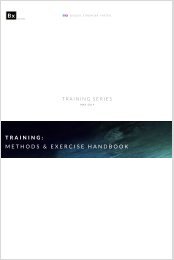Create successful ePaper yourself
Turn your PDF publications into a flip-book with our unique Google optimized e-Paper software.
HTKSPORT<br />
PART I: TRAINING FROM<br />
THE INSIDE, OUT<br />
If you want a car to run faster, you don’t go out and<br />
thrash it more. You get under the hood and work on the<br />
engine.<br />
Training from ‘the inside, out’ means using the body’s natural adaptive ability to<br />
create training methods. The human body is the ultimate adaptive machine, it will<br />
adapt to whatever you consistently tell it to do. If you think of the human body as a<br />
machine with an internal engine, then 1) the external structures are an adaptive<br />
response to the output of the internal ‘engine’ (nervous system), and 2) the overall<br />
performance can only be significantly improved by addressing the capacity of the<br />
engine. The best athletes are not the best because they’ve spent more time playing<br />
the particular sport or competition they’re the best at. Nor are the fastest athletes fast<br />
because they have some secret speed drills, or the best Olympic lifters have some<br />
magical program; they’re better because they have a better machine.<br />
Imagine a car – if you want the car to be faster you wouldn’t go out and thrash it more<br />
on the road; you’d open the hood and beef up the engine. The human body should be<br />
treated the same way - physical performance is like driving the car: an expression of<br />
the inner and structural physiology (engine and machinery). While we’re all genetically<br />
different structurally, our internal engines (nervous system) are all made of the same<br />
stuff – anyone can improve their physical performance in any capacity by re-wiring<br />
their nervous system. The physical structures will adapt over time to whatever the<br />
nervous system is trying to do.<br />
Once we understand that the nervous system is ultimately responsible for every<br />
physiological function of the human body, it makes sense to start any approach to<br />
training with the nervous system. Therefore it makes sense to ask, for any given<br />
performance, ‘what am I asking my body to do in order to achieve that performance?’<br />
The various types of neural input are discussed at length below in PART 2.<br />
01<br />
JUNE 2018 | ISSUE 01




